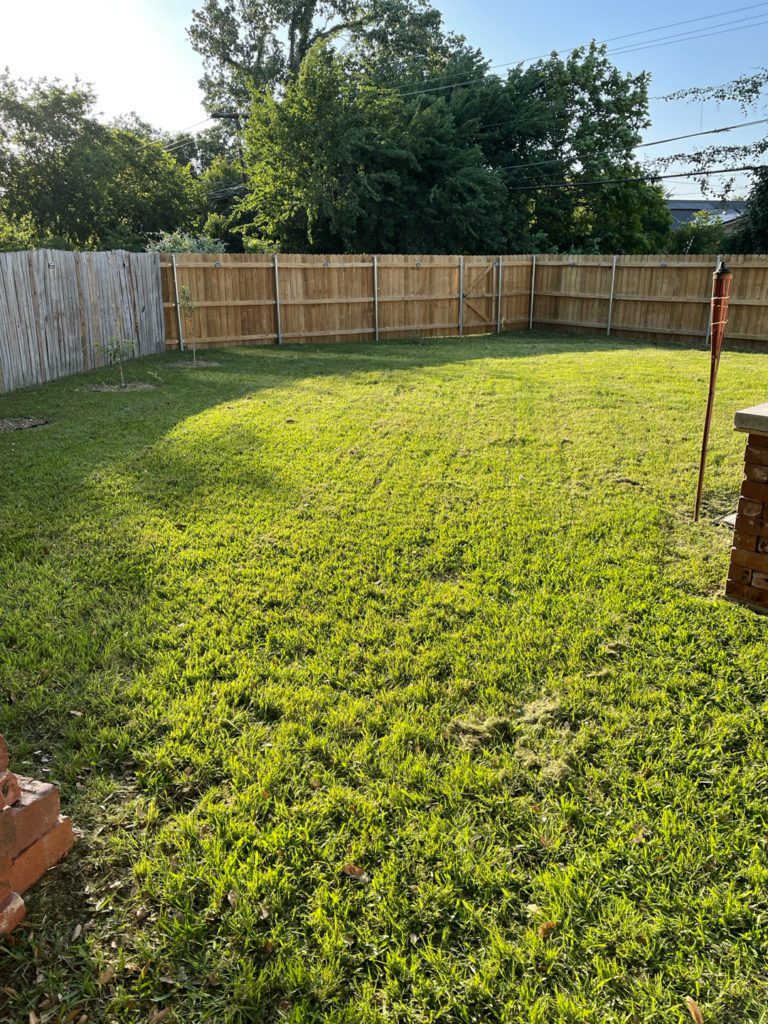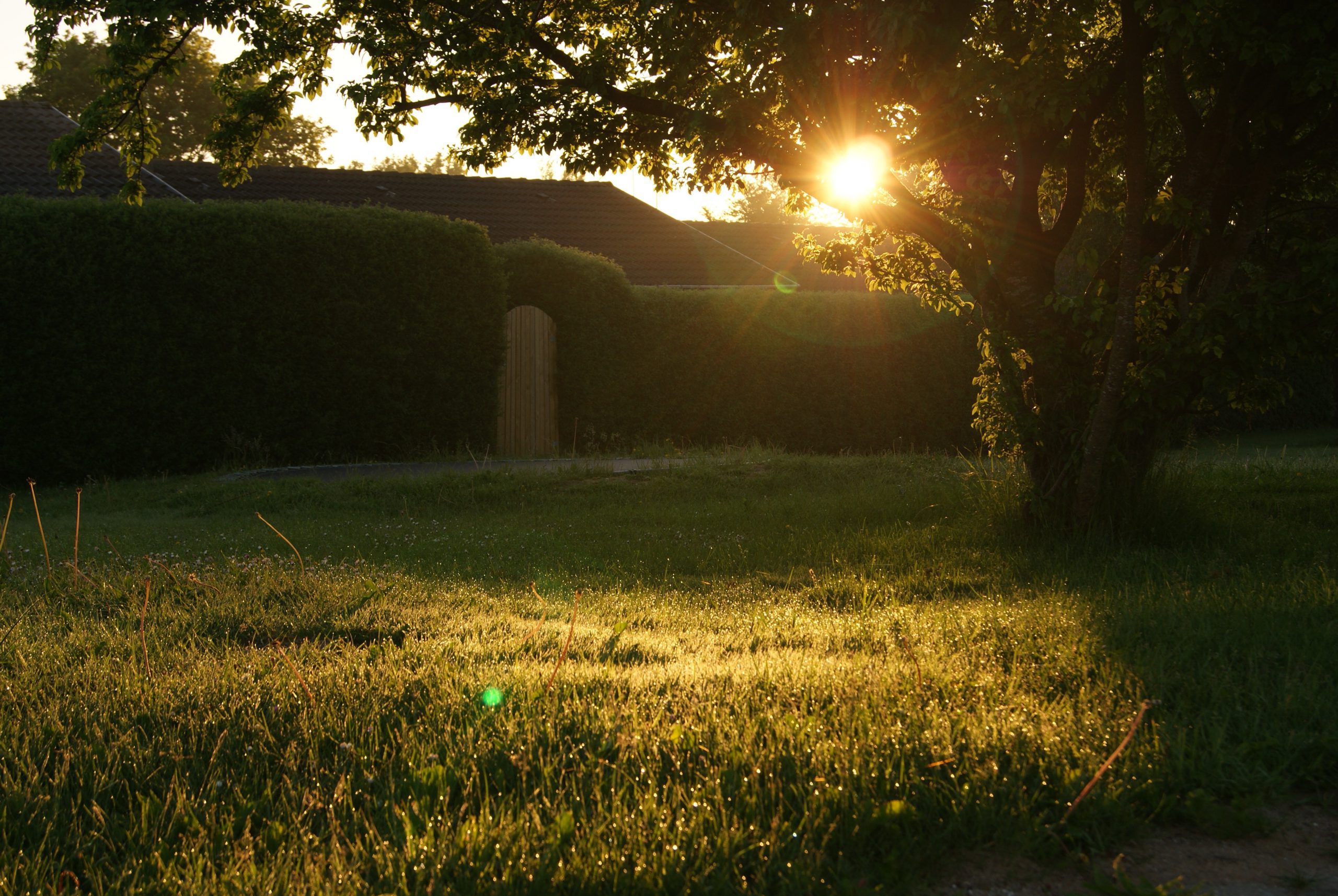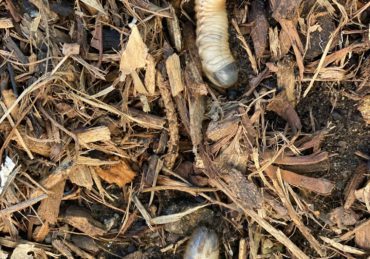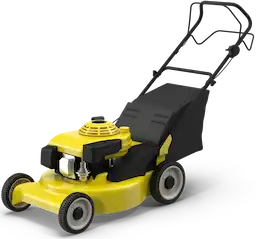To level an uneven lawn, start by mowing it short to identify low and high spots. Mark these areas with stakes or flags. For mild to moderate unevenness, apply a thin layer of top dressing—mix topsoil and sand—and use a rake to spread it evenly, ensuring grass blades remain visible. For severe unevenness, you may need to contemplate regrading, which can require professional help. After leveling, water thoroughly and maintain your lawn by mowing at a higher setting and avoiding heavy foot traffic. Follow these steps, and you’ll have a healthier, more beautiful lawn in no time!
What Causes an Uneven Lawn?
An uneven lawn can result from both natural and human causes.
Soil settling after construction or tree roots disrupting the surface are common natural culprits.
Meanwhile, poor drainage and heavy foot traffic often stem from human activities.
Understanding these factors will help you tackle the issue effectively and restore your lawn’s evenness.
Easily hire the best lawn & landscape pros working in your neighborhood.
Natural Causes
While you might love your lawn, various natural causes can lead to uneven surfaces that detract from its beauty.
Soil settling after heavy rains or construction can create depressions, contributing to an uneven lawn. If you have poor drainage, water may pool in low spots, worsening the issue.
Regular wear and tear from foot traffic can compact soil, making it uneven over time. Furthermore, tree roots and other underground obstructions can disrupt the surface, causing bumps and dips.
Inconsistent mowing heights can also play a role, as varying grass lengths emphasize low and high areas.
Human Causes
Natural factors aren’t the only culprits behind an uneven lawn; human activities can greatly contribute to the problem as well.
Soil settling after construction or landscaping can create those pesky depressions you notice. Poor drainage, often from improper grading or compacted soil, leads to water pooling, making uneven lawns even worse.
Also, if you’re inconsistent with mowing heights, those low spots will stand out against taller grass. Don’t forget about tree roots; as they grow, they can disrupt the soil surface.
Finally, heavy foot traffic in high-use areas compresses the soil, leading to unsightly depressions.
Why You Should Level Your Lawn

Leveling your lawn isn’t just about aesthetics; it greatly enhances safety and functionality. An even surface reduces tripping hazards, making your outdoor space safer for kids, pets, and guests.
Plus, leveling your lawn improves irrigation and drainage, preventing water from pooling in low spots and ensuring your grass gets the moisture it needs. Healthier grass thrives with better access to sunlight and nutrients, creating a lush, vibrant lawn that everyone can enjoy.
Regularly addressing unevenness not only boosts appearance but also protects your equipment from damage caused by scalping.
Invest a little time in leveling your lawn, and you’ll create a welcoming environment that fosters connection and enjoyment for everyone who steps onto your property.
Step-by-Step Guide to Leveling an Uneven Lawn
To level your uneven lawn effectively, you’ll first need to assess how severe the unevenness is.
Categorize the areas as mild, moderate, or severe to choose the right leveling method.
Once you’ve done that, you’ll be ready to tackle the issue head-on and restore your lawn’s beauty.
Assess the Unevenness
How can you effectively assess the unevenness of your lawn? Start by mowing it to a shorter height, which helps you spot any uneven spots, especially those low areas.
Once mowed, mark these high and low areas using stakes, flags, or spray paint to visualize the unevenness clearly.
Next, evaluate the severity: is it mild (under 1 inch), moderate (1-3 inches), or severe (over 3 inches)? This assessment will guide your leveling method.
If you find the unevenness moderate to severe, consider getting a professional evaluation to guarantee you tackle the problem effectively.
Don’t forget to clear away any debris and check for excessive thatch, as this can hinder your leveling efforts.
Choose the Right Method Based on Severity
When you notice your lawn’s unevenness, choosing the right method based on its severity can make all the difference in achieving a smooth, healthy yard.
For mild unevenness (under 1 inch), apply a thin layer of top dressing, mixing topsoil and sand, and rake it evenly to fill in low spots without smothering grass.
If the unevenness is moderate (1-3 inches), remove excess soil from high areas and topdress the low spots, compacting lightly for stability.
For severe unevenness (over 3 inches), it’s best to seek professional help, as significant soil manipulation may be needed.
After leveling, water the area thoroughly to help the soil settle and encourage grass growth, ensuring your lawn thrives beautifully.
Easily hire the best lawn & landscape pros working in your neighborhood.
How to Level Mild to Moderate Unevenness
To level mild to moderate unevenness in your lawn, you’ll first need to gather your tools and materials, including a garden rake and a leveling mixture of topsoil and sand.
Once you’ve got everything ready, apply the topdressing evenly across the affected areas, focusing on filling low spots and smoothing out high ones.
This straightforward approach will help you achieve a flatter, healthier lawn in no time.
Gather Your Tools and Materials
Before diving into leveling your lawn, you’ll need to gather some essential tools and materials that will make the process smoother and more effective.
Start with a garden rake and a shovel to help spread your topsoil and sand mixture evenly across the low spots. A wheelbarrow will make transporting materials easier, while a thatch rake can help you prepare the surface by removing any excess debris.
If you want a compacted finish, consider using a lawn roller after you spread your mixture. This will help settle the soil and eliminate air pockets.
With these tools in hand, you’ll be ready to tackle those uneven areas and create a lawn that’s beautiful and inviting for everyone!
Apply Topdressing or Soil Mix
Leveling mild to moderate unevenness in your lawn can be achieved by applying a topdressing mix, which not only smooths out the surface but also promotes healthy grass growth.
Mix equal parts topsoil and sand to create your topdressing mix, ensuring better drainage. Spread a thin layer across the entire lawn, paying special attention to those low spots, and keep the grass blades visible for sunlight.
Use a garden rake to smooth it out, making sure to eliminate any clumps or air pockets that could hamper growth. After application, water thoroughly to help settle the soil and encourage the grassroots to push through.
Repeat as necessary to maintain a beautifully even lawn you can be proud of!
How to Level a Severely Uneven or Sloping Lawn
If your lawn has severe unevenness or slopes greater than 3 inches, it might be time to evaluate regrading.
You’ll need to weigh the benefits of hiring a professional against tackling the project yourself, as heavy machinery may be required for substantial changes.
Evaluating the situation carefully will help you determine the best approach to achieve a level, healthy lawn.
When to Consider Regrading
When dealing with a severely uneven or sloping lawn, you might find yourself facing issues that go beyond simple cosmetic concerns.
Here are four signs it’s time to reflect on regrading:
- Severe Unevenness: If your lawn has pronounced variations over 3 inches, regrading is essential to restore a proper level.
- Drainage Problems: Standing water in low spots can harm your lawn; regrading helps create a uniform surface for better water flow.
- Soil Settling: After construction or heavy rain, you might notice depressions that need attention.
- Obstructions: Tree roots or other underground issues causing bumps require regrading for a smoother, more usable lawn.
Addressing these problems through regrading can greatly enhance your lawn’s health and aesthetics.
Professional Grading vs. DIY
Deciding between professional grading and DIY methods for leveling a severely uneven or sloping lawn can greatly impact the outcome of your project.
If your lawn has variations over 3 inches deep, professional grading is often the best choice. Experts have the heavy machinery and skills needed to remove or add soil effectively, ensuring long-lasting results.
On the other hand, if you’re tackling mild to moderate unevenness, DIY leveling can be a rewarding challenge. You’ll just need topdressing materials and some elbow grease.
While DIY can save money, it may not address drainage issues or provide the tailored solutions that professionals offer.
Weigh your options carefully—sometimes investing in professional help yields the healthiest lawn in the long run.
Tips for Maintaining a Level Lawn After Grading
To keep your lawn level and thriving after grading, it’s essential to establish a consistent maintenance routine. Follow these tips to guarantee your grass blades grow strong and healthy:
- Water regularly: Keep the soil moist, especially after leveling and top-dressing with organic matter.
- Mow at a higher setting: This minimizes stress on new grass and helps it establish properly.
- Fertilize: Provide nutrients after leveling to support robust grass growth and recovery.
- Limit foot traffic: Avoid heavy use of the lawn until the grass is well established to prevent soil compaction.
Common Problems Caused by a Bumpy Lawn (and How to Fix Them)
An uneven lawn can lead to several common problems that not only affect its appearance but also its usability and safety.
Visible lumps and bumps make your yard look unsightly, diminishing your property’s appeal. These uneven surfaces create tripping hazards, especially for kids and elderly guests.
You may also notice equipment damage, as mowers struggle with uneven terrain, leading to scalping and higher maintenance costs.
Moreover, low spots can cause drainage issues, resulting in muddy patches that ruin the lawn’s usability.
To fix these problems, consider applying new sod and top-dressing with organic material like compost to smooth out the surface.
Regular maintenance will keep your lawn looking great and safe for all your outdoor activities!
Need Help? Get Your Lawn Leveled Fast with LawnGuru!
If you’ve been struggling with an uneven lawn that detracts from your outdoor enjoyment, LawnGuru can connect you with local professionals ready to help.
Here’s how they can assist you in leveling uneven lawns and give your lawn the care it deserves:
- Instant Quotes: Get tailored estimates based on your lawn’s size and condition.
- Expert Assessment: Professionals evaluate the severity of unevenness and suggest customized solutions.
- Quality Service: Access to a network of qualified experts guarantees effective leveling.
- Easy Scheduling: Simplify service management so you can focus on what matters.
With LawnGuru, you can achieve a smooth, healthy lawn that enhances your outdoor space and invites you to enjoy it more!





